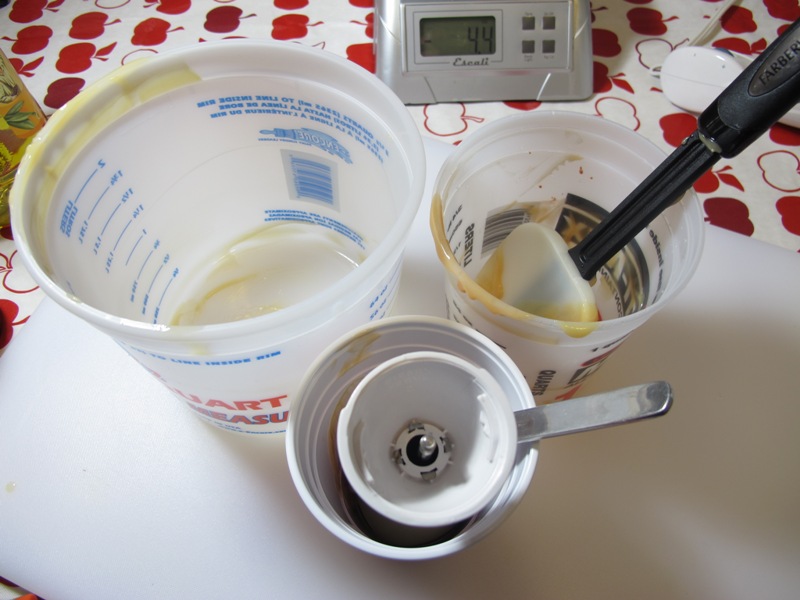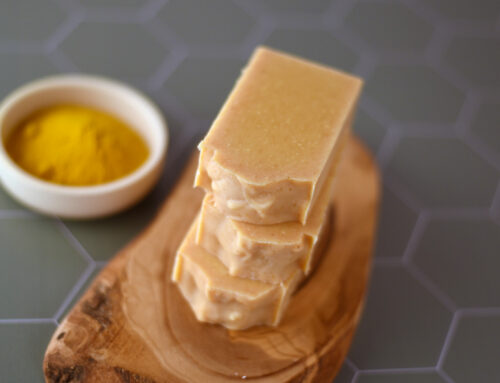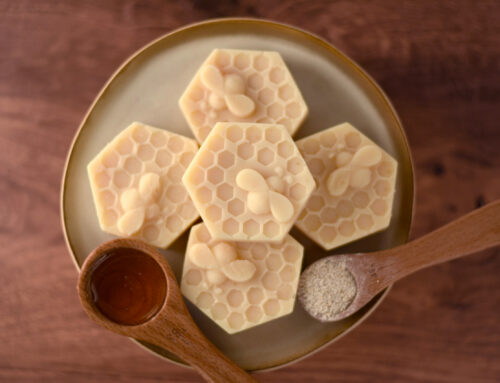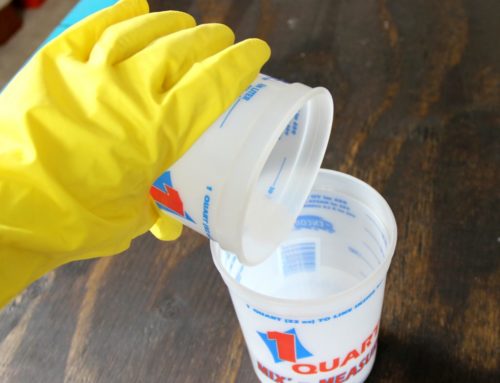One of the questions I get asked quite often either in classes or by email is how do you clean up after a soap making session.
There are two schools of thought.
- Clean up right away or
- Leave the dishes sitting around until the next day when they will have turned into soap.
I often do several batches in a row so I tend to clean up right after a batch. I also don’t really like dirty dishes sitting around. If you’re cleaning up right after a batch you want to wipe as much raw soap as you can from containers, utensils…mixing buckets…etc. You really don’t want the raw soap to go down your drain. At this point…it’s really oily and you know you’re not supposed to pour oil down the drains. I simply use paper towels and wipe out/off as much as possible.
If I leave my dishes to sit overnight to turn to soap I still wipe out as much raw soap as possible so I’m not having to scrape off thick layers of soap the next day.
To help clean your stick blender fill up a container with hot water and run the blender in it. Sometimes the blades can be a pain to clean so this helps with that. This is also a good tip if your stick blending different colors of soap in a row for a multi-colored design. Between each color, dip your stick blender into the hot water and blend for a couple of seconds and move on to the next color.
I tend to use plastic cups when doing multi-colored swirls so I can just throw them away instead of having to wash. Although I guess that could be a bit wasteful. It does cut down on the cleaning.
Here are some more tips for cleaning up right after you make soap.
- Lye solution: This can be poured down the drain, as it is used as a drain cleaner. However, you should never put raw soap down the drain, as it can clog very easily.
- Dry lye container and lye solution container: Rinse with water and wash with soap.
- Batch and mixing containers: Anything with raw soap should be wiped down before washing. Use paper towels to wipe the raw soap out of containers and discard. Then rinse and wash as usual. Some soapmakers recommend wiping with cloth towels, allowing the towels to sit overnight to saponify, and then laundering. But the superfat (excess oil) in soap can clog your washing machine and leave a gunky residue, so I don’t recommend this.
- Stick blender and utensils: Wipe down with paper towels and then wash with soap and water. Make sure your stick blender is turned off before cleaning!
- Molds: If you’re using silicone molds, simply rinse the soap off. No need to wash. If you’re using wooden molds and some soap escaped your liner, just use a knife or scraper to scrape off the hardened soap; no need to wash.
- Some soapmakers leave all their soapmaking dishes until the next day, when everything has turned to soap and can be rinsed and put away. If you’re not in a hurry, there’s no harm in letting things sit overnight.
- A vinegar solution can be used to spray down your workspace to neutralize any lye that might have gotten onto the surface. I also keep a spray bottle of alcohol to clean up oily residue from my scale, stick blender base, and bottles of oils that might dribble as I pour.
- Wear gloves as you’re wiping containers and your stick blender, as traced soap is still caustic and can burn.
Do you have any tips for easier cleanup? Please leave a comment!
Happy Cleaning!
Amanda







I just make soap every couple of weeks, and I have a place that I can hide all of the soapy pans and stick blender. So after a couple of days…when I get around to it :-)…I scrape the sides of the soapmaking pot and make little balls out of the soap that is still sticking to the pot. I put those little balls in a ziplock bag so that they won’t completely harden. I especially value the really colorful soap leftovers and they will always make an appearance in a later soap. I have a drawer in my dining room that has nothing in it but ziplock bags with little soap balls in every color. After I scrape out the soaping pot, I add hot water to it and run the stick blender to clean the blades. If I have a floor that needs to be cleaned then that water will be used for mopping. I know this wouldn’t work for everybody, but it works for me!
I also like to clean up straight away. We have a septic tank so I am used to not letting a lot of stuff go down the drain, etc. I use newspapers to clean out as much of the raw soap as possible and then use paper towels. That way I don’t waste paper towels and the newspaper really gets alot of the raw soap out. I wash with really hot water and detergent. I also lay newspapers down on my workspace so any spills, or utensils with soap on them can easily be rolled up when I am finished and it makes cleaning up so easy. I also save the plastic containers that I get food in from take out restaurants like the soups you get from Chinese restaurants. These are really nice to use for mixing soap & colors in.
My tip? I get my hubby to do it for me!
Great tips, Amanda! I like to do it right away too. Wiping out as much raw soap as possible with paper towels really is the key in my opinion. And super hot water to wash with, that helps too! =)
Great tips Amanda. I did a little YT video about how I clean up. Thanks to some tips from a friend, I now wipe out as much soap as possible as well right at first. I do let my dishes sit until I can get to them because they are out of sight/out of mind for me and there is no rush for me to wash. So in the meantime, I fill my lye solution container with water and then soak my stick blender attachment and other utensils. It’s a great help and the soap just rinses off when I am ready to wash. I don’t have to scrub or fight with any of the clean-up. It’s a breeze!
Hey Holly! What is the link to your video? I’d love to link to it in the post if possible. Thanks!
Here’s the link the my video…not too excited but anyway… 😀
Okay, totally meant to say ‘exciting’. Doh!
Thanks! You have a TON of great videos! I know what I’m doing the rest of night! lol